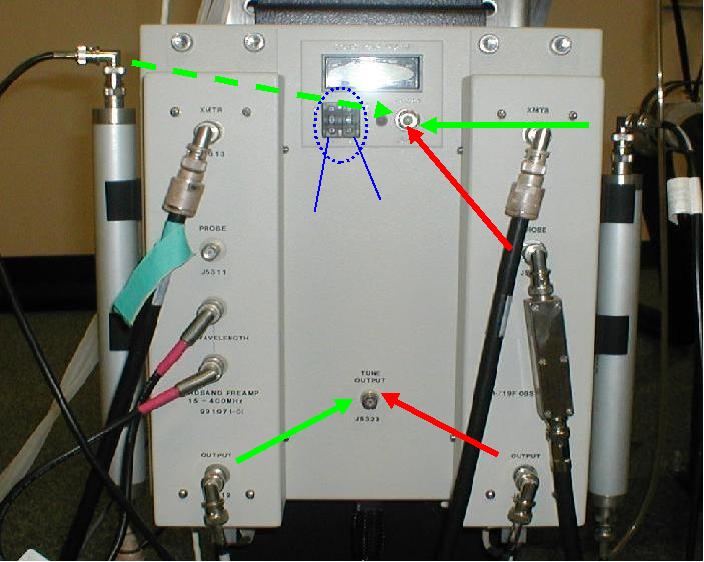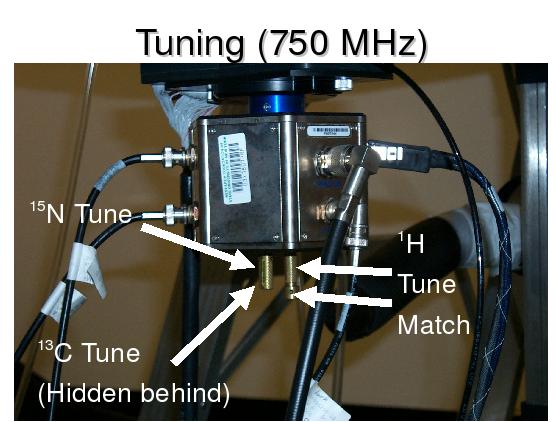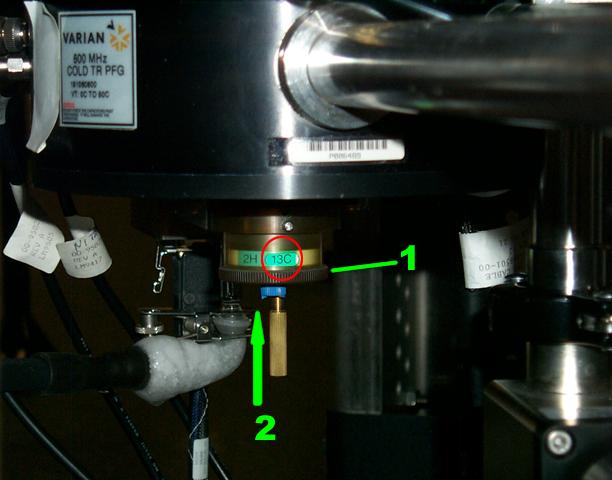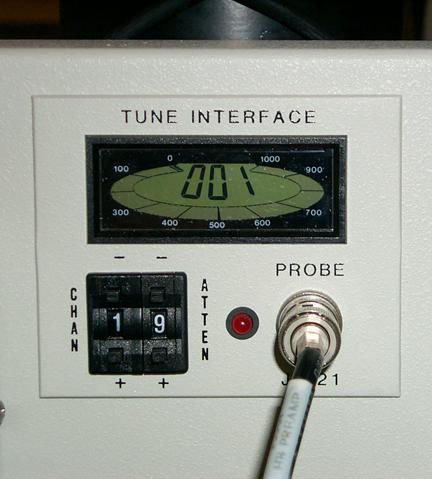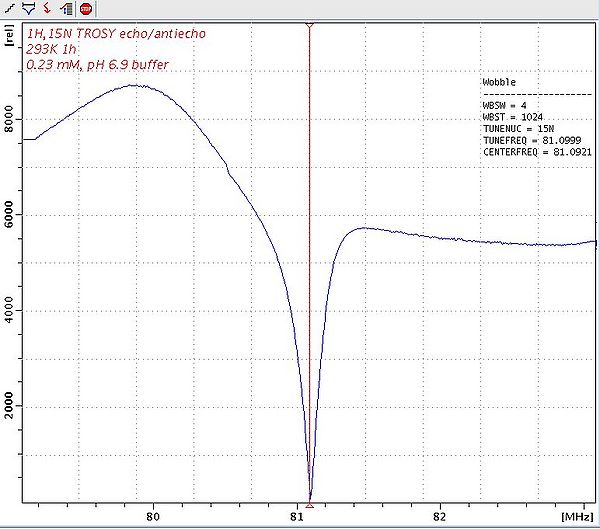Tuning and matching: Difference between revisions
(Created page with '== '''Probe Tuning and Matching''' == NMR probes come in various designs, but the typical triple-resonance HCN probe has two coils and four resonant circuits. The inner observe …') |
No edit summary |
||
| (7 intermediate revisions by 2 users not shown) | |||
| Line 1: | Line 1: | ||
== '''Probe Tuning and Matching''' == | == '''Probe Tuning and Matching''' == | ||
NMR probes come in various designs, but the typical triple-resonance HCN probe has two coils and four resonant circuits. The inner observe coil is connected to 1H and 2H circuits, and the outer decoupling coil is connected to 13C and 15N circuits. | NMR probes come in various designs, but the typical triple-resonance HCN probe has two coils and four resonant circuits. The inner observe coil is connected to 1H and 2H circuits, and the outer decoupling coil is connected to 13C and 15N circuits. | ||
In general, a resonant circuit can be tuned to the frequency of the corresponding nucleus and matched to the standard impedance of the connecting lines (50 Ohm). This is usually achieved by adjusting two variable capacitors in the circuit. Tuning and matching reduces reflected power and increases the quality factor Q, leading to shorter pulse widths and better sensitivity (and to stronger radiation damping). | In general, a resonant circuit can be tuned to the frequency of the corresponding nucleus and matched to the standard impedance of the connecting lines (50 Ohm). This is usually achieved by adjusting two variable capacitors in the circuit. Tuning and matching reduces reflected power and increases the quality factor Q, leading to shorter pulse widths and better sensitivity (and to stronger radiation damping). | ||
Often a circuit can only be tuned, but not matched. For example, cryogenic HCN probes typically allow both tuning and matching of the 1H circuit, but only allow tuning of the 15N, 13C or 2H circuits. The 2H circuit of room-temperature HCN probes can usually be neither tuned nor matched. | Often a circuit can only be tuned, but not matched. For example, cryogenic HCN probes typically allow both tuning and matching of the 1H circuit, but only allow tuning of the 15N, 13C or 2H circuits. The 2H circuit of room-temperature HCN probes can usually be neither tuned nor matched. | ||
=== '''Channel Setup''' === | === '''Channel Setup''' === | ||
Tuning and matching can only be done for the nuclei assigned to a channel. To tune 1H, 15N, and 13C you can: | Tuning and matching can only be done for the nuclei assigned to a channel. To tune 1H, 15N, and 13C you can: | ||
*Load any triple-resonance or HSQC data set and type <tt>su</tt> | |||
*In any dataset define <tt>tn='H1' dn='C13' dn2='N15' su</tt> | |||
If you also want to tune the 2H channel add <tt>dn3='H2' su</tt> | |||
To perform tuning and matching of a probe you have to re-cable the probe to connect it to the tuning bridge. The tuning bridge has a monitor displaying the amount of reflected power - the aim is to minimize its reading. | === '''Cable Connection''' === | ||
To perform tuning and matching of a probe you have to re-cable the probe to connect it to the tuning bridge. The tuning bridge has a monitor displaying the amount of reflected power - the aim is to minimize its reading. | |||
The cable connections depend on the probe type and the magnet leg configuration. For detailed desription consult these manuals: | The cable connections depend on the probe type and the magnet leg configuration. For detailed desription consult these manuals: | ||
==== '''1H Channel - Room-Temperature HCN or 5NUC Probe''' ==== | *For room-temperature probes see '''Section 6.5''' of the [http://www.varianinc.com/image/vimage/docs/products/nmr/apps/pubs/manuals/0199916000b.pdf VNMR 6.1C Getting Started] manual. | ||
*For cryogenic probes see [http://www.varianinc.com/image/vimage/docs/products/nmr/apps/pubs/manuals/0199919600c.pdf Gen 1 HCN Cold Probe Manual] or [http://www.varianinc.com/image/vimage/docs/products/nmr/apps/pubs/manuals/0199930000c.pdf Gen 2 HCN Cold Probe Manual] | |||
==== '''1H Channel - Room-Temperature HCN or 5NUC Probe''' ==== | |||
#Locate the cable going from the '''1H''' or '''Observe''' port on the probe to an RF filter. | |||
#Disconnect it from the filter and connect it to the '''J5321''' port on the tune interface | |||
#If '''J5323 TUNE OUTPUT''' port is available, disconnect the cable from '''J5302 OUTPUT''' port on the 1H preamp and connect it to the '''J5323 TUNE OUTPUT''' port. | |||
#Select channel 1 on the tune interface | |||
#Adjust tuning and matching using knobs | |||
#Return the cables to their original positions | |||
==== '''1H Channel - Cryogenic HCN Probe''' ==== | |||
#Disconnect the cable from the '''J5303 HB XMTR''' port on the 1H preamp | |||
#Take a short cable and connect it to the '''J5303 HB XMTR''' port and the '''J5321''' port on the tune interface. | |||
#If '''J5323 TUNE OUTPUT''' port is available, disconnect the cable from '''J5302 OUTPUT''' port on the 1H preamp and connect it to the '''J5323 TUNE OUTPUT''' port. | |||
#Select channel 1 on the tune interface | |||
#Adjust tuning and matching using knobs | |||
#Return the cables to their original positions | |||
[[Image:Tunebox2.jpg]] | |||
[[Image:Tunebox3.jpg]] | |||
''Fig. 1. 600 MHz at SUNY Buffalo: original cable position (left), 1H tuning and matching position (right).'' | |||
==== '''13C, 15N and 2H Channels - All Probes''' ==== | |||
#Locate the cable going from the respective 13C, 15N or 2H port on the probe to an RF filter. | |||
#Disconnect it from the filter and connect it to the '''J5321''' port on the tune interface | |||
#If '''J5323 TUNE OUTPUT''' port is available, disconnect the cable from '''J5312 OUTPUT''' port on the broadband preamp and connect it to the '''J5323 TUNE OUTPUT''' port. | |||
#Select the corresponding channel (2, 3 or 4) on the tune interface | |||
#Adjust tuning and matching using knobs | |||
#Return the cables to their original positions | |||
[[Image:Tunebox.jpg]] | |||
''Fig. 2. 600 MHz SUNY Buffalo: cable to be reconnected for 13C and 15N matching (green arrows).'' | |||
=== '''Additional Notes''' === | |||
There is often some cross-talk between tuning and matching capacitors of the same circuit. The effect is negligible near the tuning optimum, and the two capacitors can be adjusted in an interleaved fashion with a few iterations. But the cross-talk makes it more difficult to tune a badly mis-tuned probe, getting you stuck in a local minimum. If this happens, one has to "undo" one of the capacitors and adjust the other one, aiming to find the global minimum by trial and error. | |||
A cross-talk can also exist between different circuits, however, it has not yet been observed with our probes. To minimize this cross-talk it is recommended to tune the low gyromagnetic ratio channels first: 15N -> 2H -> 13C -> 1H. | |||
As a general rule, 1H tuning and matching depends strongly on the ionic strength of the sample, and usually differs for aqueous samples and those in organic solvents. 13C and 15N tuning shows much weaker dependence on the ionic strength. | |||
Tuning 2H is not required unless you have to pulse on 2H, but it may improve lock sensitivity. On the other hand, since experiments involving pulses on 2H, such as 2H-decoupling, are run very rarely, it is likely that the 2H circuit is mis-tuned. | |||
[[Image:Tune750.jpg]] | |||
''Fig. 3. 750 MHz SUNY Buffalo: tuning knobs, room-temperature HCN probe.'' | |||
[[Image:Tune500.jpg]] | |||
''Fig. 4. 500 MHz SUNY Buffalo: tuning knobs, room-temperature 5NUC probe.'' | |||
[[Image:Tune600a.jpg]] | |||
''Fig. | ''Fig. 5. 750 MHz SUNY Buffalo: tuning knobs, cryogenic HCN probe.'' | ||
[[Image:Tunebox4.jpg]] | |||
''Fig. 6. Tune interface.'' | |||
== Tuning and Matching Bruker on Spectrometers == | |||
On Bruker spectrometers equipped with TopSpin 2.0 and up, there are two methods for tuning and matching probes. | |||
=== Standard Probeheads === | |||
For standard probeheads lacking the automatic tuning and matching functionality, tuning and matching is initiated for an experiment using the command: | |||
<pre>wobb | |||
</pre> | |||
A wobble page opens up (see Figure below): | |||
[[Image:Wobb.jpg|600px]] | |||
Tuning | According to the spectrometer set up in the current experiment (defined using the edasp command), the tuning display starts with lowest frequency nucleus in the experiment (for example, <sup>15</sup>N). Proceed to the magnet and adjust the tuning and matching knobs for that nucleus. Tuning moves the minumum in the display left or right, and matching moves it up and down. The object is to center this "peak" and make it is low as possible. At the same time, follow the relected power on the pre-ampliflier LED. | ||
Next, press the change nucleus icon at the top of the wobb display, and the system with move to the next highest frequency nucleus (i.e., <sup>13</sup>C). Continue the process until <sup>1</sup>H tuning and matching is complete. | |||
=== ATM probeheads === | |||
Bruker probeheads equipped with the automated tuning and matching (ATM) feature, do not have tuning/matching rods. Instead the user tunes and matches using the automated tuning and matching dialog box initiated by the command: | |||
<pre>atmm | |||
</pre> | |||
Here an interactive dialog box (not shown) is opened analogous to the wobb display above, where the user can adjust tuning and matching by clicking buttons in the display. | |||
For completely automatic tuning and matching, the command is: | |||
<pre>atma | |||
</pre> | |||
<br> | |||
-- | <br> -- GaohuaLiu - 24 Jan 2007 | ||
Latest revision as of 23:22, 4 December 2009
Probe Tuning and Matching
NMR probes come in various designs, but the typical triple-resonance HCN probe has two coils and four resonant circuits. The inner observe coil is connected to 1H and 2H circuits, and the outer decoupling coil is connected to 13C and 15N circuits.
In general, a resonant circuit can be tuned to the frequency of the corresponding nucleus and matched to the standard impedance of the connecting lines (50 Ohm). This is usually achieved by adjusting two variable capacitors in the circuit. Tuning and matching reduces reflected power and increases the quality factor Q, leading to shorter pulse widths and better sensitivity (and to stronger radiation damping).
Often a circuit can only be tuned, but not matched. For example, cryogenic HCN probes typically allow both tuning and matching of the 1H circuit, but only allow tuning of the 15N, 13C or 2H circuits. The 2H circuit of room-temperature HCN probes can usually be neither tuned nor matched.
Channel Setup
Tuning and matching can only be done for the nuclei assigned to a channel. To tune 1H, 15N, and 13C you can:
- Load any triple-resonance or HSQC data set and type su
- In any dataset define tn='H1' dn='C13' dn2='N15' su
If you also want to tune the 2H channel add dn3='H2' su
Cable Connection
To perform tuning and matching of a probe you have to re-cable the probe to connect it to the tuning bridge. The tuning bridge has a monitor displaying the amount of reflected power - the aim is to minimize its reading.
The cable connections depend on the probe type and the magnet leg configuration. For detailed desription consult these manuals:
- For room-temperature probes see Section 6.5 of the VNMR 6.1C Getting Started manual.
- For cryogenic probes see Gen 1 HCN Cold Probe Manual or Gen 2 HCN Cold Probe Manual
1H Channel - Room-Temperature HCN or 5NUC Probe
- Locate the cable going from the 1H or Observe port on the probe to an RF filter.
- Disconnect it from the filter and connect it to the J5321 port on the tune interface
- If J5323 TUNE OUTPUT port is available, disconnect the cable from J5302 OUTPUT port on the 1H preamp and connect it to the J5323 TUNE OUTPUT port.
- Select channel 1 on the tune interface
- Adjust tuning and matching using knobs
- Return the cables to their original positions
1H Channel - Cryogenic HCN Probe
- Disconnect the cable from the J5303 HB XMTR port on the 1H preamp
- Take a short cable and connect it to the J5303 HB XMTR port and the J5321 port on the tune interface.
- If J5323 TUNE OUTPUT port is available, disconnect the cable from J5302 OUTPUT port on the 1H preamp and connect it to the J5323 TUNE OUTPUT port.
- Select channel 1 on the tune interface
- Adjust tuning and matching using knobs
- Return the cables to their original positions
Fig. 1. 600 MHz at SUNY Buffalo: original cable position (left), 1H tuning and matching position (right).
13C, 15N and 2H Channels - All Probes
- Locate the cable going from the respective 13C, 15N or 2H port on the probe to an RF filter.
- Disconnect it from the filter and connect it to the J5321 port on the tune interface
- If J5323 TUNE OUTPUT port is available, disconnect the cable from J5312 OUTPUT port on the broadband preamp and connect it to the J5323 TUNE OUTPUT port.
- Select the corresponding channel (2, 3 or 4) on the tune interface
- Adjust tuning and matching using knobs
- Return the cables to their original positions
Fig. 2. 600 MHz SUNY Buffalo: cable to be reconnected for 13C and 15N matching (green arrows).
Additional Notes
There is often some cross-talk between tuning and matching capacitors of the same circuit. The effect is negligible near the tuning optimum, and the two capacitors can be adjusted in an interleaved fashion with a few iterations. But the cross-talk makes it more difficult to tune a badly mis-tuned probe, getting you stuck in a local minimum. If this happens, one has to "undo" one of the capacitors and adjust the other one, aiming to find the global minimum by trial and error.
A cross-talk can also exist between different circuits, however, it has not yet been observed with our probes. To minimize this cross-talk it is recommended to tune the low gyromagnetic ratio channels first: 15N -> 2H -> 13C -> 1H.
As a general rule, 1H tuning and matching depends strongly on the ionic strength of the sample, and usually differs for aqueous samples and those in organic solvents. 13C and 15N tuning shows much weaker dependence on the ionic strength.
Tuning 2H is not required unless you have to pulse on 2H, but it may improve lock sensitivity. On the other hand, since experiments involving pulses on 2H, such as 2H-decoupling, are run very rarely, it is likely that the 2H circuit is mis-tuned.
Fig. 3. 750 MHz SUNY Buffalo: tuning knobs, room-temperature HCN probe.
Fig. 4. 500 MHz SUNY Buffalo: tuning knobs, room-temperature 5NUC probe.
Fig. 5. 750 MHz SUNY Buffalo: tuning knobs, cryogenic HCN probe.
Fig. 6. Tune interface.
Tuning and Matching Bruker on Spectrometers
On Bruker spectrometers equipped with TopSpin 2.0 and up, there are two methods for tuning and matching probes.
Standard Probeheads
For standard probeheads lacking the automatic tuning and matching functionality, tuning and matching is initiated for an experiment using the command:
wobb
A wobble page opens up (see Figure below):
According to the spectrometer set up in the current experiment (defined using the edasp command), the tuning display starts with lowest frequency nucleus in the experiment (for example, 15N). Proceed to the magnet and adjust the tuning and matching knobs for that nucleus. Tuning moves the minumum in the display left or right, and matching moves it up and down. The object is to center this "peak" and make it is low as possible. At the same time, follow the relected power on the pre-ampliflier LED.
Next, press the change nucleus icon at the top of the wobb display, and the system with move to the next highest frequency nucleus (i.e., 13C). Continue the process until 1H tuning and matching is complete.
ATM probeheads
Bruker probeheads equipped with the automated tuning and matching (ATM) feature, do not have tuning/matching rods. Instead the user tunes and matches using the automated tuning and matching dialog box initiated by the command:
atmm
Here an interactive dialog box (not shown) is opened analogous to the wobb display above, where the user can adjust tuning and matching by clicking buttons in the display.
For completely automatic tuning and matching, the command is:
atma
-- GaohuaLiu - 24 Jan 2007


